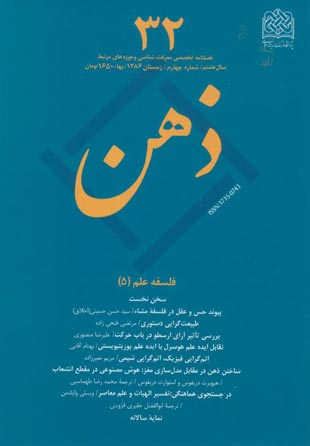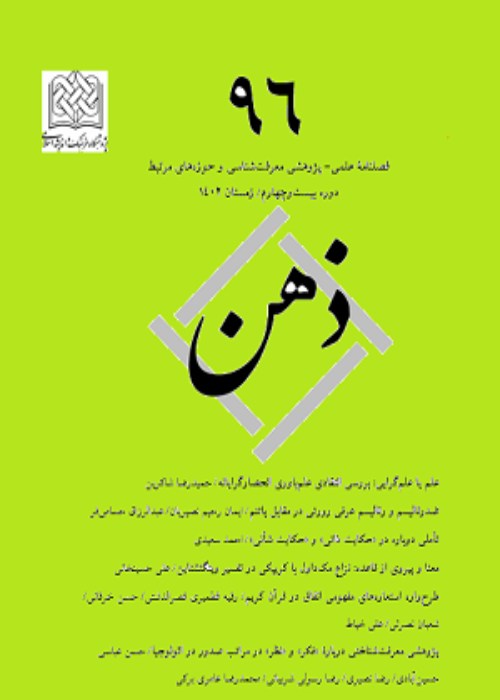فهرست مطالب

فصلنامه ذهن
سال هشتم شماره 4 (پیاپی 32، زمستان 1386)
- 192 صفحه، بهای روی جلد: 16,500ريال
- تاریخ انتشار: 1386/10/24
- تعداد عناوین: 9
-
صفحه 1
-
صفحه 29
-
صفحه 107
-
صفحه 179
-
Page 3This study is aimed to provide a clear narration concerning the relation between the sense on the one hand and reason and rationality on the other. The reasons behind selection of this theme are, firstly, importance of this subject in the philosophical thinking and secondly obsoleteness of the subject; thirdly, here is a subject studied which is a permanent companion of philosophy. For this reason, in addition to Sinean logic, essays such as Farabi’s al-Ta‘liqat, Ibn Sina’s al-Ta‘liqat, Ibn Tufayl’s Hayy ibn Uaqzan which have remained unnoticed as well as issues mentioned by Khwajah Nasir and Ibn Rushd will be reflected upon. The study seeks to clarify the unique place of sense perception in the process f acquisition and evaluation of rational knowledge, and show that the Peripatetic philosophers admit the important requirement of this principle (limitation of the sources of knowledge to sense) i.e. unaccessibility of the reality of things. To adopt such an approach will led to propagationof public rationality, and open new windows for philosophical studies, and may throw a new light on the Islamic Peripateticism and its possibilities.Keywords: sense, reason, empiricism, Peripatetic philosophy, concept, judgment, empirical logic
-
Page 29Larry Lauden's normative naturalism is a meta-epistemological synthesis concerning the place of epistemology and is directed to justify it. This meta-epistemology is, on the one hand, naturalistic, for like all naturalist epistemologies, it accepts naturalist and empiric methodology and deems it as the only methodology which is suitable for evaluation and justification of epistemic claims (whether scientific, or philosophical, or conventional). Thus, it is descriptive and non-prescriptive. Lauedn's metaepistemology is, on the other hand, a normative and prescriptive synthesis; for, it considers description of epistemological rules and norms, "ought"'s and "ought not"s to acquire and evaluate our beliefs concerning the world as "the traditional and old role of the theory of knowledge. Thus, it is prescriptive and non-descriptive. Lauden thought that both descriptive and prescriptive properties of epistemology are necessary and irremovable. And taking into account, descriptive and empiric character of the naturalistic methodology of science as well as normative character of the traditional epistemology, he tries to reduce one to the other and shows that epistemology is able to play its traditional role and accept empirical evidence, and be evaluated in the same way that other scientific and claims are, at the same time. The present essay aims to study and examine such an attempt.Keywords: Lauden, Normative naturalism, naturalistic meta, methodology, network rationality
-
Page 69In the present article, through a case study, the author aims to criticize the thesis of complete incommensurability of theories through study of the influence of Aristotle's ideas concerning motion on modern science and evaluation of its capabilities in the light of achievements of the modern science. In this regard, innovative views of Ibn Sina and Mulla Sadra concerning the above issue, as compared to those of Aristotle, have been mentioned as well.Keywords: Motion, incommensurability, Aristotle, Mach Principle
-
Page 87Reduction of science to the mere fact by positivism is the focus of the present article. To explain such an idea, at the beginning Husserl goes to describe his own idea of science and considers it in line with the ancient ideal of philosophy i.e. universal knowledge. In this way, he deems this idea as consisting of absolute and universal validity of its statements, attaining a systematic whole of knowledge… Then, he goes to analyze the positivist idea of science which, according to him, reveals itself in aspects of philosophy of worldview, historicism, and mathematization of the nature. According to Husserl, historicism, philosophy of worldview and the like as various forms of positivism pave the way to limit the concept of science to the mere objective reality or a spiritual formation which depends upon gradual development. According to him this has led, on the one hand, to limitation of the universe to the universe of bodies or physicalist nature, and reduction of all metaphysical questions to the mere objective reality.Keywords: Husserl's Idea of Science, positivistic science, historicism, mathematization of the nature
-
Page 107The principle of atomismmay be traced back to Democritus, and it has been the foundation of thinking in the 17th and 18th Centuries. In the 17th Century, Boyle who had inherited the theory of atomism from atomist philosophers of Greece, made uses of this theory. In the 18th Century, Lavasie accepted atomism as an empirical hypothesis, and took the “element” as a “principle”. In this century, Dalton discusses based on the Lavazie’s developed conception of chemical element. In the present article, the author has tried to discuss views of Boyle and Dalton, and finally find distinction between atomism in Chemistry and Physics.Keywords: Boyle's atmoism, Dalton's atomism, distinction between Boyle's atmoism, Dalton's atomism
-
Page 115In the mid-20th Century when computers appeared, there emerged a hypothesis according to which such machines are similar to man's mind, and as computer sciences develop and progress, scientists will be able to manufacture such computers which enjoy all capabilities of man's mind. This project was called artificial intelligence, and its advocates assumed some fundamental similarity between man's mind and its intelligent capabilities on the one hand and computer on the other. And as computer sciences progress, we will face artificial minds. To achieve this goal, scientists of the field adopted two main approaches; the approach based on computer sciences was more welcomed. In this article, firstly, the author shows that which philosophical idea underlies the approach based on computer sciences, i.e. semiology; and causes of defeat of this approach have been studied. And secondly, the author has tried to show that how in the field of philosophy i.e. in the field of the ideas of later Wittgenstein and Heidegger, modern views have changed the approach to the project of artificial intelligence; and to give a more promising position to the second approach which may be called connectionism.Keywords: semiology, connectionism, reductionism, holism
-
Page 149A discussion of science and religion in the contemporary period could justifiably present a historical narrative of the major scientific advancements and theological movements in the twentieth century along with the key developments in the rapidly growing specialization of religion and science. This approach would illumine the origins of the specialization as well as the events that have shaped it. Another approach is to examine the relationship between the contemporary study of science and religion, and its Western cultural environment. Historical narrative is less important in this approach, while interpretation and argument are more prominent. However, such an analysis promises desirable insights into the potential importance of the specialization of religion and science. This is the approach taken in this essay. Accordingly, the first part of this paper offers a sweeping glance at those features ofcontemporary Western culture that are most pertinent to the emergence and modification of what can be called its "critical spirit." The second part aims to relate science, religion, and the study of their interaction to this cultural analysis, in a bidirectional way.Keywords: science, religion, theology


